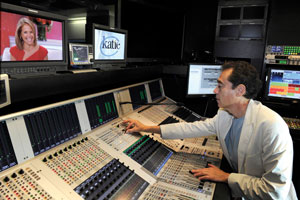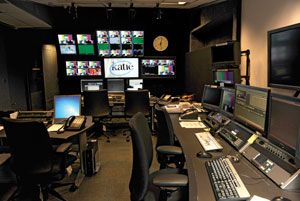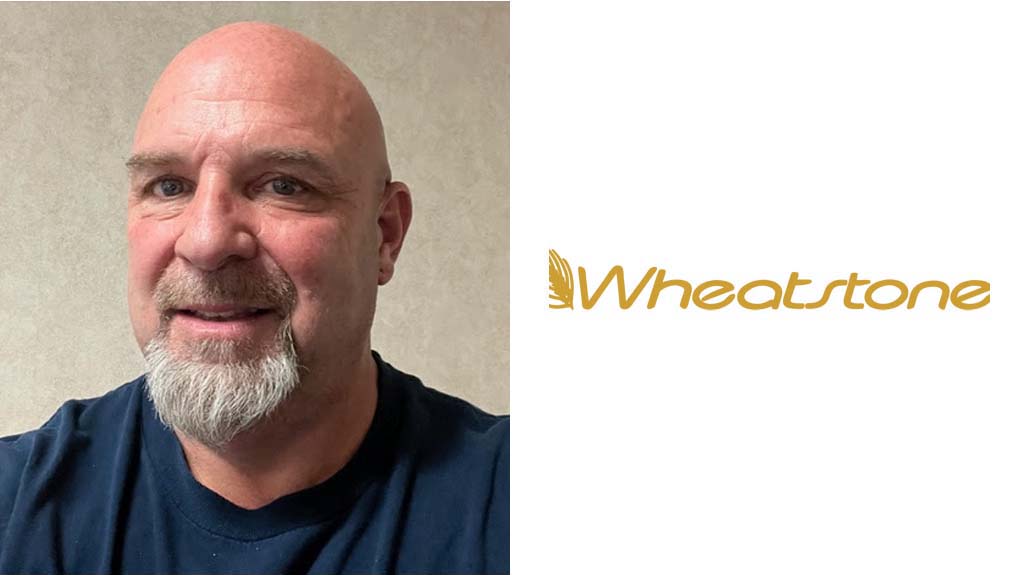System Design Showcase: The Katie Couric studio gets a new HD production facility
In September 2011, when the Disney/ABC Television Group (DATG) announced that it would launch a new daily syndicated show featuring Katie Couric, the daunting task was to create a new studio for the program.
The first order of business was to find a suitable HD “home” for the show. After reviewing several possible locations, it was decided that facilities within the ABC Television Center on West 66st in New York would be updated and become the new location for Katie.
As it happened, the facilities used by the syndicated show “Who Wants to Be a Millionaire” would become available after “Millionaire” finished its production season in November 2011. The new season of “Millionaire” was scheduled to move to another ABC facility, which freed up the studio, control room and technical support spaces for the necessary upgrades.
The production facility for “Katie” includes studio TV-1, control room TV-7 and support spaces built in what was originally TV-1’s control room. One great advantage of the setup is the adjacency of these three workspaces.
An additional pre/post-production facility, built specifically for “Katie,” is co-located with the show offices in an ABC building on Columbus Avenue.
Syndicated show
Because it is a syndicated show rather than a network show, “Katie” does not use any of the ABC Network program origination, graphics or post-production facilities. For other than incoming remotes and outbound feeds to DATG’s uplink provider, the new stand-alone facility incorporates production, post, commercial integration and show playout.
These requirements drove the design of critical areas in the production process, including the development of the media center in one of the support spaces and the pre/post-production facility at the Columbus Avenue facility.
The professional video industry's #1 source for news, trends and product and tech information. Sign up below.
Broadcast Operations and Engineering (BO&E) executives had a general guideline that informed every decision made in designing the studio. The plan was to use the best, proven technologies to build a facility that would allow the “Katie” team to implement its vision for the show and would allow it to change and adapt easily to meet evolving show requirements.
In order to achieve this goal, a working group consisting of representatives from the BO&E, DATG and show staff was formed to develop the requirements for the new facility. The BO&E staff was tasked with implementation of these requirements.
Technical infrastructure
The TV-7 control room complex, including production control, audio and transmission, was originally built in 1995 as an SD facility. In preparation for the upgrade to HD, all equipment and cabling was removed. Only racks and power were left in place.

A 60-fader Studer Vista 9 audio console, supported by two Soundcraft mixers, serves the show’s needs, including supporting appearances by live musical acts. Recent acts have used rental equipment that includes Riedel RockNet interfaces.
The technical core of the facility is built around a 288 x 288 Evertz EQX router. Based on the concepts developed for ABC’s HD central switching, the router interface between sources and destinations that are not local to the main TV-7 control room complex is implemented via fiber-based I/O. Fiber interfaces are provided for the connectivity to the ABC’s Central Core for incoming remotes and outbound programming, for connectivity to the Media Center and the Columbus Avenue pre/post facility.
Evertz X-Link and VIP-X technology, integral to the routing system, is used for multiviewer-based monitoring in the control room, audio room and the media center.
Production control room
A Sony MVS-7000X production switcher, fitted with 80 inputs and 48 outputs, was selected.
The original CRT-based monitor wall was replaced by an LCD-based monitor wall driven by the Evertz VIP-X system. Individual Ikegami 17in camera monitors and 32in line/preview monitors by Penta complete the monitor wall.

The design team set aside a space within the former TV-1 control room for use as a media center. The media center is built around an EVS server system, and is responsible for the integration of national commercials.
Live graphics/lower thirds are generated by a dual-channel Chyron HyperX. Moving backgrounds and clips are managed by a four-channel Ross SMS server and a 12-channel Abekas Mira server.
Content for the Chyron and servers can be produced at the graphics workstations in the Columbus Avenue facility and transferred to these devices, as files, via the network linking the two spaces.
Audio
A 60-fader Studer Vista 9 audio console was selected as the centerpiece of the audio production facility. It is supported by a Soundcraft Si Compact 32 music/backup mixer and a Soundcraft Vi4 mixer for front of house.
The main console is equipped with 64 AES I/O, 56 analog line inputs, 64 analog line outputs and 24 mic inputs. Using MADI technology and the Evertz audio routing system described earlier, the setup provides an additional 128 MADI-based I/O.
An ENCO DAD TV central audio storage and playout system provides redundant storage of audio-only elements. The system is fully redundant, with a storage capacity of 2TB.
It is also networked to the Columbus Avenue post facilities, allowing audio clips to be prepared/edited and then transferred to the ENCO system for air.
The main EQX router is integrated with an Evertz EMR audio routing system. The EQX router I/O cards include de-embedding and re-embedding of audio, which is linked to the EMR router via TDM links. The EMR router provides I/O to the Vista 9 via redundant MADI paths.
This implementation allows flexible allocation of audio tracks to video sources. By using the virtual routing capability of the Evertz system, multiple audio tracks can be assigned to video sources, greatly simplifying the creation of camera ISOs with different audio track assignments.
A Riedel RockNet networked audio system provides connectivity from studio mics and return line channels for IFB, etc. One of the unique features of this redundant system is that it allows the FOH mixer and main Vista 9 mixer to independently control mic preamp gains via RockNet interfaces integrated into the mixers.
The show includes appearances by a variety of live musical acts. Most live performances are mixed on rental equipment that is brought in as required. Recent live music acts have used rental equipment that includes RockNet interfaces, reducing setup time significantly.
The audio production suite includes a space that houses the equipment and operating station for the communications system that links all of the spaces that comprise the production facility. The two existing RTS/Telex ADAM frames were upgraded and now include RVON capability.
Studio
TV-1 studio is a 7000sq-ft stage adjacent to the TV-7 control room. As part of the upgrade, the studio was fitted with SMPTE camera fiber. A basic complement of video, audio and intercom capability was provided at each of five broadcast service panels (BSP) located around the perimeter of the studio.
At the beginning of the design process, the layout of the show’s set was not known, so the studio had to be provided with the flexibility required to accommodate any set design. Rather than install large amounts of copper for audio and video, roll-round stage boxes, which allow concentration of audio and video connectivity as needed by the final set design, were provided.
Audio connectivity is provided as part of the studio’s RockNet network. There are 96 mic/line inputs and 48 line outputs available on the studio floor.
For floor video feeds, the team took advantage of the fiber-based capability of the router. Twelve of the router’s fiber-based destinations are supplied to a custom-built optical splitter located on the studio floor. Splits appear on Opticon Quad connectors at each BSP. The stage boxes are equipped with O/E conversion, providing 12 routable video feeds at each stage box.
Six Ikegami HDK-725 cameras, in both studio and handheld configuration, provide the basic camera complement. Lenses range from 60x studio lenses to 11x4.7 wide-angle ENG style. One of these is mounted on a telescopic Techno-Jib 24.
On-set displays are important to the “look” of the set. Custom-built matrices of 60in LCD monitors in portrait mode, including an 8 x 2, 5 x 1 and 2 x 1, allow production to display graphics or incorporate video elements into the show.
Sources to these displays are processed by an Evertz DVT videowall processor. Inputs to the processor are derived from the main EQX router, so that any image, graphic or video element can be fed to these displays.
An 80in touch screen driven by custom software allows Couric to dynamically interact with graphics or live video as topics are discussed.
Media center
One of the original operating premises was that the show would air live at 2 p.m., with updates or fixes made during the 2 p.m. live broadcast for replay to the 3 p.m. affiliates. In addition, the capability to pre-record shows on a segment-by-segment basis and edit the individual segments into a complete show, ready for broadcast, was required.
Because it is a syndicated show, the integration of national commercials and playout of the show to DATG’s uplink provider had to be incorporated into the workflow. To implement these requirements, a space within the former TV-1 control room was re-imagined as a media center.
The media center is built around an EVS system, consisting of three 6-channel XS servers and a single 4-channel XS server. Management of the main record and playout workflow is done at the main EVS workstation, which includes the routing and monitoring tools needed to manage this workflow. This workstation manages the recording of programming and ISOs, as well as playout of commercials and pre-recorded show elements.
A second operating position includes an EVS IP Edit workstation, designed to allow show fixes to be made on the spot. A live 2 p.m. broadcast can be updated as the show moves forward, to be ready for replay at 3 p.m.
An EVS IP Director provides the media management tools. There are also IP-Director-based media monitoring workstations for browsing or reviewing content in the production control room and in the Columbus Avenue facility. The media center is closely integrated with the Columbus Avenue facility, via file-based transfer, as well as baseband video. The file-based-transfer capability is a key ingredient in the show’s workflow.
Commercials are ingested into the ISIS system at the Columbus Avenue edit facility, QC’ed and transferred, as files, to the EVS system for integration into the show. Commercials are played out on two EVS channels, on independent XS servers, to assure a high level of redundancy.
Program playout to AMV via redundant paths is controlled and monitored in the media center. When the show is pre-recorded, playout is accomplished using independent XS channels and fed to AMV via redundant paths.
Columbus Avenue facility
A pre/post-production facility is co-located with the show’s Columbus Avenue production offices. This facility is integrated with the main production facility via network and baseband video via fiber. Its primary use is to produce pre-recorded show elements, which are then transferred as files to the EVS in the media center for playout. Commercial ingest and transfer to EVS for playout is also managed in this space.
The file-transfer-based workflow allows show elements to be transferred at 3X- to 4X-real time from the ISIS to EVS for playout. The Avid edit capabilities include a Symphony suite, four Media Composer suites, two Media Composer workstations and 12 Avid Assist kiosk workstations.
The edit suites run under Interplay and are networked to a 64TB ISIS on-line storage system and an HP 144TB near-line NAS storage system.
Graphics are composed on three graphics workstations running Cinema 4D and Adobe CS Master Suite. The network that links this facility to the production complex also allows file-based transfer of content from the graphics machines to the Chyron and Ross and Abekas servers, which in turn become sources to the on-set displays.
A Pro Tools AudioSuite can provide sweetening for edited pieces and also provides audio clips, via network, to the ENCO audio system in the control room.
Up and running
“Katie” premiered on Sept. 10, 2012, and as the production staff has “exercised” the facility, the flexibility that was one of the design goals of the project has allowed BO&E to quickly respond to requests for adjustments in routing, monitoring and studio-floor feeds.
As the show has developed, the use of the file-based Avid-EVS interface has increased. Working with Avid and EVS, the workflow has been refined to improve file-transfer speed and clip management.
Design team
- ABC-Daytime/Times Square Studios: Dominick Nuzzi, Sr. VP, production and administration
- “The Katie Show”: James Tomlinson, Executive in Charge of Production; Bob Peterson, Creative Director; Joe Terry, Director
- ABC (BO&E): Todd Donovan, Sr. VP, (BO&E); Kenneth Michel, VP Engineering; William Rego, GM, Live Production and Special Events; Ellen Zalk, Director, Client Services; David Linick, Manager, Broadcast Engineering; Robin Thomas, Group Director of Engineering; Chris Bauer, Director of Engineering; Phil Durante, Director, Technical Construction; Jay Katowitz, Manager, Technical Construction; Mike Zdyrko, General Manager, Media Systems
- On-set displays: Videofilm Systems
- Custom touch screen: Controlled Entropy
- Systems Integration — production complex: The Systems Group, Hoboken, NJ
- Columbus Avenue post facility: Bexel Broadcast Services
Technology at work
- Abekas: Mira servers
- Avid: Symphony, Media Composer, Interplay media management, ISIS online storage, Pro Tools AudioSuite
- Bosch: RTS ADAM intercom
- Canon: 60X and 25X studio lenses, 17X handheld lenses, Telescopic Techno-Jib 24
- Chyron: HyperX on-air graphics system
- Cisco: Networking equipment
- Cobalt Digital: Color corrector
- DNF: Device control ENCO: DAD TV networked audio record/playback system
- Evertz: DVT display-wall processor, VIP-X multiviewer, EQX router, coax/fiber
- EVS: XS servers, IP Edit, IP Director
- HP: Near-line storage
- Ikegami: HDK-725 and 725P cameras, camera monitors
- NEC: Multiviewer monitors
- Penta: Line/preview monitors
- Riedel: RockNet mic/IFB distribution system
- Ross: SMS server
- Sony: MVS-7000X production switcher
- Soundcraft: Compact 32 music mixer, Vi4 FOH mixer
- Studer: Vista 9 audio console
—David Linick is manager, broadcast engineering for ABC broadcast operations and engineering.
